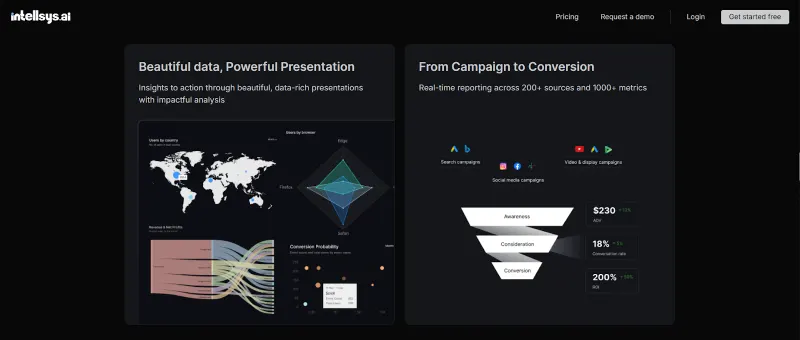Multi Touch Attribution: Pick the Right Model to Triple Your Marketing ROI in 2025

Your CEO just asked the question every marketer dreads: "Which campaign actually drove that ₹50 lakh deal?"
You pull up Google Analytics, then Meta Ads Manager, then your CRM. Three platforms, three different answers. Google claims their search ads sealed it. Meta insists their retargeting campaigns did the heavy lifting. Your email platform waves frantically from the corner, claiming credit for those seven nurture touches.
Does the situation sound familiar? You're stuck in attribution hell, where every platform fights for credit like relatives at a wedding buffet.
The truth is that the customer didn't convert because of one magical touchpoint. They saw your LinkedIn ad, Googled your brand two weeks later, clicked a retargeting ad, downloaded your guide, and finally booked a demo after getting your email. Multi touch attribution captures this entire journey, not just the final click that lazy metrics love to celebrate.
Companies using multi touch attribution report ROI improvements of up to 30%. But what’s the main reason? It’s because you stop wasting budget on what looks good in last-click reports and start funding what actually drives the pipeline.
We'll decode every attribution model, show you exactly how Google and Meta handle attribution differently (with real screenshots), and hand you a decision framework that actually works. Plus, we'll show you how Intellsys.ai turns attribution from a quarterly spreadsheet exercise into real-time revenue intelligence.
What is multi touch attribution?
If you are asking what is an attribution model, it is the rule set that decides how much credit each touchpoint gets.
Multi touch attribution assigns a credit to every marketing touchpoint that influences a conversion.
In contrast, traditional last-click attribution is like thanking only the waiter who brings your food while ignoring the chef who cooked it.
Multi touch attribution tracks the complete journey: the Instagram ad that sparked awareness, the blog post that built trust, the retargeting campaign that reminded them, and the email that sealed the deal.
Each touchpoint gets its fair share of credit based on the attribution model you choose.
This sits alongside marketing mix modelling (MMM) for macro-level insights and incrementality testing for causal proof. MMM shows channel-level impact; incrementality proves causation through experiments; multi touch attribution reveals the tactical journey details.
5 different attribution models in plain English
Let's decode each multi touch attribution model without the MBA-speak. These practical models decide where your next marketing dollar is invested. So, let’s understand marketing attribution models better!
1. Linear attribution: Every touchpoint gets equal credit
Linear attribution splits credit equally across all touchpoints.
If a customer interacted with five channels before converting, each gets 20% credit. Simple, fair, and utterly democratic.
When it works: Short sales cycles with 3-5 touchpoints where every interaction genuinely matters. Perfect for impulse purchases or low-consideration products where the journey is quick and every touch counts.
When it doesn't: Complex B2B journeys where a white paper download shouldn't carry the same weight as a sales demo. You'll overvalue top-funnel activities and undervalue conversion-drivers.
2. Time decay attribution: Recent touches win
Time decay gives more credit to recent touchpoints.
That first blog visit three months ago? Minimal credit. Yesterday's retargeting ad? Maximum points. It follows a half-life model where attribution value decays exponentially.
When it works: Products with short consideration windows (under 30 days) where recent interactions genuinely indicate buying intent. Fashion e-commerce and flash sales thrive here.
When it doesn't: Enterprise software with 6-month sales cycles where early education content is crucial for building the business case.
3. Position based attribution: First and last get the glory
Also called U-shaped attribution, this model gives 40% credit each to first and last touch, with the remaining 20% spread across middle interactions. It recognises that starting the conversation and closing the deal matter most.
When it works: When you need to balance brand awareness campaigns with conversion-focused efforts. Ideal for businesses running both top-funnel content and bottom-funnel performance campaigns.
When it doesn't: Complex journeys where middle touchpoints (like product demos or case study downloads) are actually your strongest conversion indicators.
4. Single-touch models: Why marketers still use them
First-click gives 100% credit to the introduction; last-click gives everything to the closer. Neither tells the complete story, but understanding both helps frame your multi touch strategy.
- First-click logic: "If they never discovered us, nothing else matters." Use this view to justify brand spending and content marketing.
- Last-click logic: "Only closers count." This feeds the performance marketing machine but starves awareness campaigns.
5. Data-driven attribution: Let the algorithm decide
Google's algorithmic approach uses machine learning to assign credit based on actual conversion patterns in your data. It analyses which touchpoint sequences lead to conversions versus those that don't.
When it works: High-volume accounts with 600+ conversions monthly across multiple channels. The algorithm needs data density to find patterns.
When it doesn't: Smaller accounts or niche B2B companies with longer cycles and fewer conversions. You'll get unreliable models that shift wildly.
Pick based on your business reality, not what sounds sophisticated. A simple linear model that you understand beats a complex algorithm you can't explain to your CFO.
Platform reality check: How Google and Meta handle attribution
Your attribution model philosophy means nothing if you can't actually implement it. Let's see what Google and Meta really offer in 2025, and why their defaults might be sabotaging your results.
Google Ads attribution models in 2025
Google offers six attribution models, but here's the catch: they're pushing everyone toward data-driven attribution (DDA) as the default. Since July 2023, new conversion actions automatically use DDA, not last-click.
What you'll see in Google Ads:
- Data-driven attribution (default): Uses your account's conversion data to distribute credit
- Last click: Still available but Google actively discourages it
- First click: For brand awareness measurement
- Linear: Equal distribution across all Google touchpoints
- Time decay: More credit to recent interactions
- Position-based: 40% first, 40% last, 20% middle
The reality: Most accounts don't have enough conversion volume for DDA to work properly. Google requires at least 600 conversions per month for reliable modelling. Below that? You're getting volatile, unreliable attribution that changes weekly.
Pro tip: Check your "Model comparison" report in Google Ads. If DDA shows wildly different results week-to-week, switch to position-based until you hit volume thresholds.
Meta's attribution: The iOS 14.5 reality
Meta's attribution got hammered by iOS 14.5 privacy changes. They've adapted, but the landscape is completely different from pre-2021.
Current Meta attribution windows:
- 7-day click, 1-day view (default): The new standard after iOS changes
- 7-day click only: Removes view-through conversions entirely
- 1-day click: For immediate response campaigns

Gone are the 28-day windows. Meta now uses Aggregated Event Measurement (AEM) for iOS traffic, which means:
- 3-day data delays for iOS conversions
- Modelled conversions to fill gaps (read: educated guesses)
The breakdown everyone misses: Meta's "7-day click, 1-day view" means someone who clicks your ad has 7 days to convert for credit, but someone who only views it has just 24 hours. This massively undervalues awareness campaigns.
Where the platforms clash
Here's where it gets messy. A customer sees your Meta ad (no click), Googles your brand next day, clicks a search ad, and buys. Who gets credit?
- Meta says: No credit (exceeded 1-day view window)
- Google says: 100% credit to search
- Reality: Meta created the demand; Google harvested it
This platform bias creates massive blind spots. You'll kill performing Meta campaigns because they show zero conversions, then wonder why Google CPCs spike as you lose the demand generation engine.
The fix: Use UTM parameters religiously and analyse in a neutral platform - track everything from Google Analytics, your CRM, etc. directly on intellsys.
How to pick a model for your business
Stop choosing attribution models based on what sounds smart in a conference room. The right marketing attribution model depends on three things: cycle length, channel mix, and data volume.
1. Your sales cycle length determines everything
Under 7 days (impulse buys): Time decay or last-click work fine. Recent touches genuinely matter most when someone goes from discovery to purchase within a week.
Your Meta ad on Monday and purchase on Friday? The Thursday retargeting ad probably deserves the credit.
7-30 days (considered purchases): Position based attribution shines here. You need to credit both the spark (first touch) and the closer (last touch).
That initial YouTube ad matters as much as the final email.
30+ days (complex B2B): Linear or data-driven attribution only. Every touchpoint in a three-month journey played a role. Don't let recency bias kill your nurture programmes that keep leads warm for months.
2. Channel diversity changes the game
- 2-3 channels: Keep it simple with linear attribution. You're not complex enough to need sophisticated models. Spend your time on creative and targeting instead.
- 4-6 channels: Position-based or time decay attribution, depending on your funnel. Multiple channels need nuanced credit distribution, but you can still understand what's happening.
- 7+ channels: Data-driven if you have volume; custom model if you don't. You've reached complexity where human logic struggles to assign fair credit.
3. Business model breaks all the rules
-
E-commerce: Time decay for regular purchases, position-based for new customer acquisition. Returning customers need different attribution from first-timers.
-
B2B SaaS: Linear for trials, position-based for enterprise deals. Your £50/month product and £50k/year enterprise deal shouldn't use the same model for B2B attribution.
-
Marketplace/Multi-vendor: Custom model or stick to platform defaults. Your attribution needs are too unique for standard models.
For marketplaces, align e-commerce attribution with seller reports and match orders by UTM, phone, or email to avoid double counting.
Quick decision matrix for attribution models
Keep what is an attribution model in mind as you scan the scenarios, then pick the rule set that matches your data and cycle.
Here's your two-minute attribution model selector.
| Your scenario | Best model | Why it works | When to switch |
|---|---|---|---|
| B2C, under ₹5,000 average order | Time decay | Recent intent signals matter most in impulse purchases | If sales cycle extends beyond 14 days |
| B2C, luxury/high-consideration | Position-based | Brand discovery and final push equally important | If middle touches (like store visits) drive conversions |
| B2B, 3-6 month sales cycle | Linear | Every touch in long cycle contributes to education | When you identify clear "moments of truth" |
| B2B, product-led growth | Data-driven | Self-serve journeys have clear patterns algorithms can find | If under 600 conversions/month |
| Multi-product catalogue | Custom/Linear | Different products need different attribution logic | Never (this complexity needs flexibility) |
| Content-heavy strategy | First-click | Proves content marketing value to stakeholders | Balance with last-click view for complete picture |
| Performance marketing focus | Last-click | Optimises for immediate conversions and ROAS | When CAC rises but revenue stays flat |
| Launching new channels | Position-based | Credits new channel tests fairly against established ones | After channel mix stabilises (6 months) |
If the chosen marketing attribution model starts to drift, run a 90-day review and document the change.
Next steps: Choose, test, and scale with confidence using Intellsys
Multi touch attribution is a means to a decision, not the finish line. Pick the model that fits your journey, validate it, then move spend with proof.
Ask yourself: which one decision will this model change next week? Where could a small shift in credit unlock a big gain?

If you want a single place to do this without rebuilding your stack, try Intellsys. It connects Google, Meta, and your CRM, shows model outputs next to lift studies on one growth dashboard.
Want speed and fewer moving parts? Try the Intellsys dashboard on a 30-day free trial.
FAQs on multi touch attribution
How often should I update my multi touch attribution model?
Review quarterly or whenever your mix, funnel length, or tracking changes. If path length, assist rates, or conversion windows shift meaningfully, rerun a model comparison and document the change.
Can multi touch attribution include offline or call-centre sales?
Yes. Sync POS or call logs to your CRM with campaign UTMs and timestamps, then ingest those conversions into your reporting. Use matching rules by phone, email, or order ID to close the loop.
What tagging and data hygiene do I need before turning on MTA?
Lock UTM standards, ensure one primary conversion per journey, dedupe events, and align lookback windows across platforms. Test a few real paths end-to-end before you trust the numbers.
Should a startup use multi touch attribution or keep last click?
Startups with low data can begin with position based or linear for clarity, then move to data driven when volume grows. Keep the setup lightweight and focus on a small set of decisions you will actually make.








